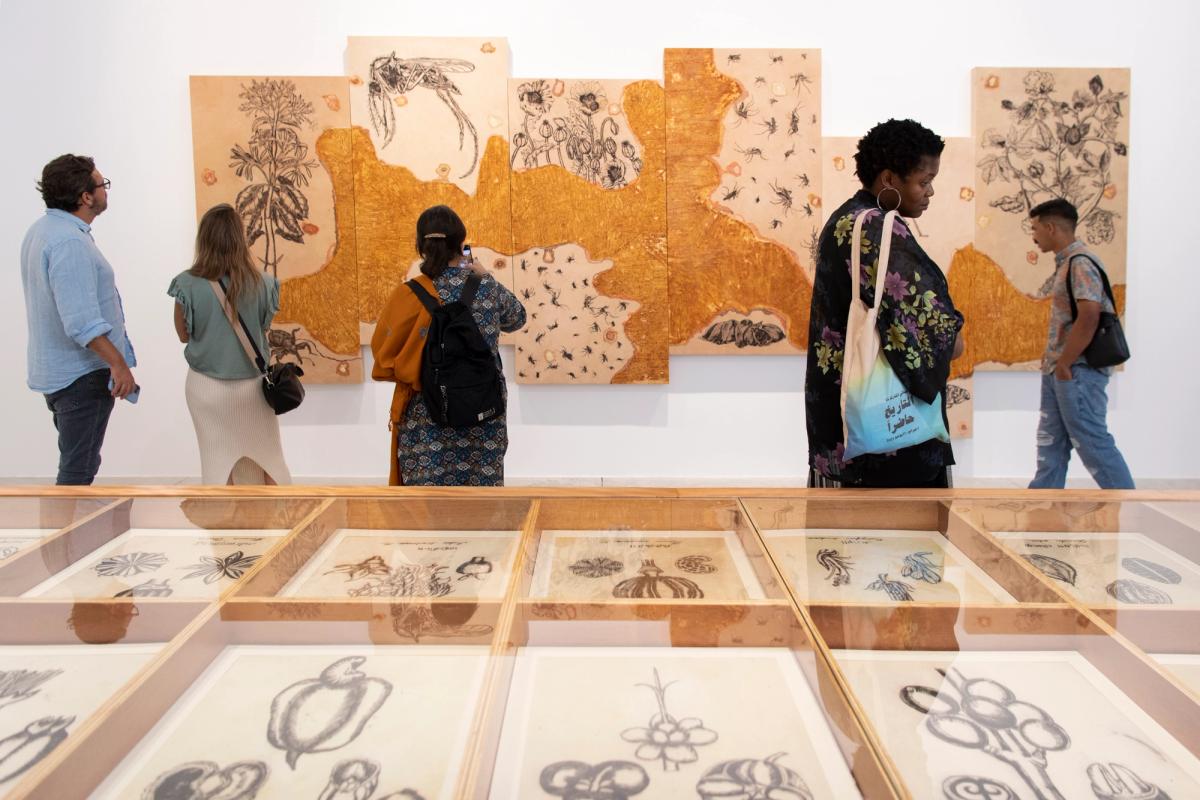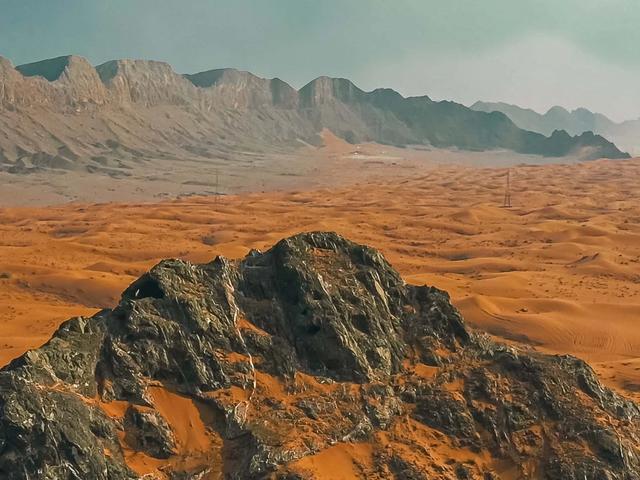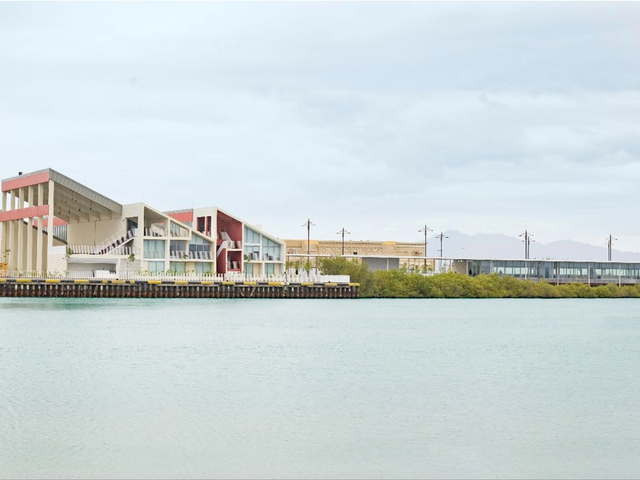Hoor Al Qasimi, the director of the Sharjah Art Foundation in the United Arab Emirates (UAE), often remarks that her perspective on what a biennial should be is anchored in the late Okwui Enwezor’s Documenta 11, which so famously contested a West-centric art canon in 2002, the year before her stewardship of the Sharjah Biennial began. More than two decades later, Sharjah Biennial 15, entitled Thinking Historically in the Present, is the influential Nigerian curator's final brainchild.
In his email to Al Qasimi in October 2018, when Enwezor had fallen ill, he saw the upcoming biennial “as a product of a certain historical development, as a module with which to deal with the disruptive power of artistic monolingualism, but also as a horizon of the possible to conceive another theoretical space for thinking historically in the present”. Following his death in 2019, Enwezor's idea of 30 new commissions for the biennial's 30th anniversary has evolved into 70 new works (out of a total of 300) spread across 19 venues with the curatorial collaboration of Al Qasimi and a working group of individuals she established who were close to Enwezor.
The biennial has always been more about holding space in a trans-regional sense, adding to global contemporary art discourse in a decentred format that brings the art world and its practices to the UAE where it is embedded, rather than the other way round. “I’m always working with what exists here,” Al Qasimi tells The Art Newspaper. “You can see this with the buildings we renovate and preserve. The Africa Institute came out of the Africa Hall. Everything has its history… I wanted to see what we could change with the biennial without copying the West. Now we are reassessing by looking at the past 30 years.”
One of the high points of the Sharjah Biennial 15 is Isaac Julien's cinematic work in Calligraphy Square. Titled Once Again... (Statues Never Die) (2022), it is arguably one of the most legible connections to the late Okwui Enwezor’s thoughts on “the postcolonial constellation”—defined as the complex geopolitical configuration that impacts and "refracts" the production and reception of contemporary art in our globalised context, as opposed to a singular Euro-American perspective—to which the Sharjah Biennial pays homage.
“Nothing is more galvanising than the sense of a culture past. When I grew up, I didn’t connect the makers of race with the makers of art… We are the shadowy figures looking for the door to a transgressive culture that will let us in,” the narrator proclaims in Julien's work, which, marked by a black-and-white mid-20th century aesthetic and a musical interlude performed on an empty stage, reads like theatre refracted on film.
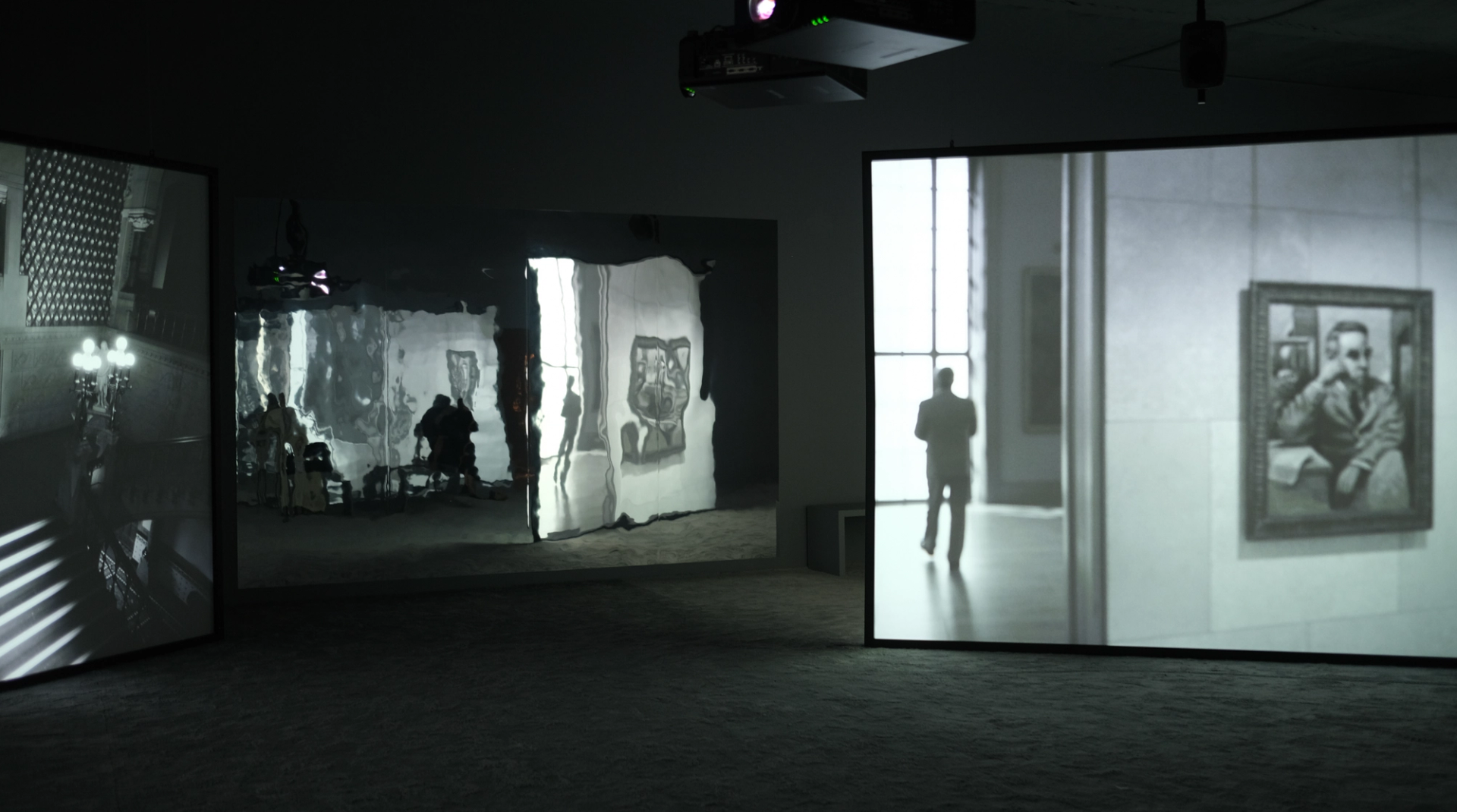
Isaac Julien's Once Again... (Statues Never Die) (2022) Photo: Sueraya Shaheen
With asynchronous images installed among five screens against a shimmering backdrop of opaque mirrors, Julien’s multi-faceted reflection of African art’s contribution to—and omission from—the Western canon includes clips of the British Museum’s looted sculptures and a re-enacted exchange between the African-American philosopher Alain LeRoy Locke and the art collector Albert Barnes on the cultural appropriation of objects and, therefore, the carriers of history.
What is inspiring about Julien is not only how he pays tribute to decolonial thinking but also how he seemed more excited to see the film As British as a Watermelon (2019)—by a young Zimbabwean UK-based artist, who goes by the name mandla rae—than talk about his own work. In the installation, made cosy with a furry carpet and plants strung with lights, the semi-fictive narrative of mandla rae’s journey through adoption and asylum was projected. "How colonised must you be not to speak your own name?” asks the non-binary artist, who recounts the changing of their adoptive name (Bridget), while hacking at a watermelon with knives.
Its pink, slushy interior evokes flesh wounds from the abuse they were subject to, forming an uncanny link to the mango as a symbol of sexual violence in Joiri Minaya’s performance Mango Slice/The King’s Wife. Here, Paul Gauguin’s painting The King’s Wife (1896) became a point of departure for exotic representations of women in the Tropics—Gaugin’s colonial gaze most disturbingly evident in excerpts that Minaya read out from his Tahitian journal. While she sliced and peeled mangoes, she invited the audience to consider “the Black and Brown body which continues to deliver sustenance despite the brutality of its existence”.
Figurative depictions of people of colour are prevalent in this Sharjah Biennial, most notably in Kimathi Donkor’s troubling paintings of the police shootings of Cherry Groce and Keith Blakelock, among others during the 1980s riots in London. Depicted in both documentary and Surrealist poses at the Sharjah Art Museum, one in particular shows two kneeling officers restraining a figure on the ground, recalling George Floyd’s murder, though their hard hats point to a different time. In this way the paintings, seemingly dated in style and reference, are not static. They index racist practices of police brutality that persist.
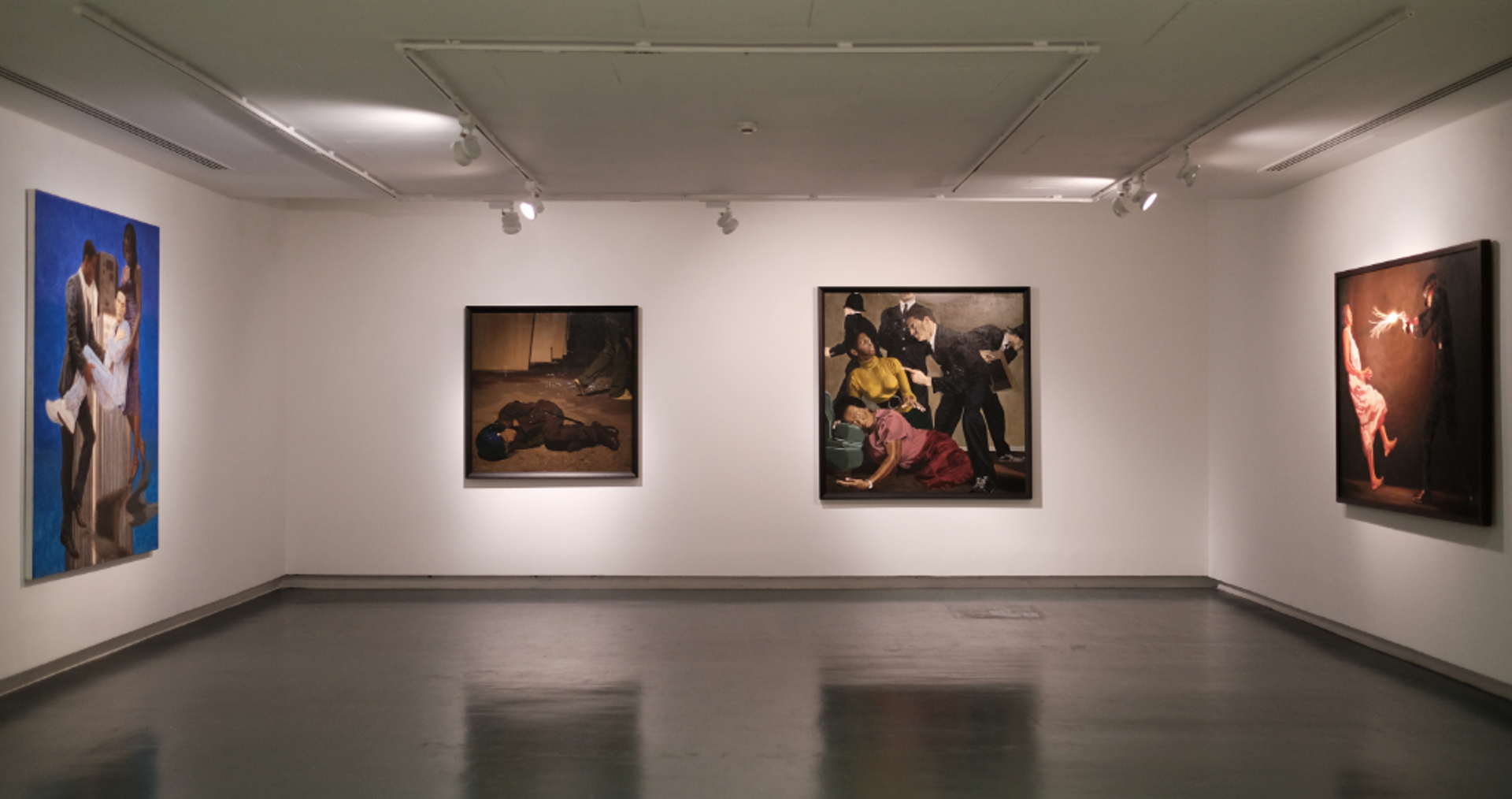
Kimathi Donkor's works at Sharjah Biennial 15 Photo: Sueraya Shaheen
Positioned near Mame-Diarra Niang's abstract photographs of diffuse Black portraits melting into brightly coloured backgrounds, entitled Léthé (2021), and Jawad Al Malhi’s saturated portrayals of solitary figures and groups in Palestine washed over with greyish-white paint, these formalist tropes present a kind of indeterminacy. Perhaps most unsettling of these are Destiny Deacon’s close-ups of Black and Aboriginal dolls with their faces cut out, entitled Smile (2017). Nearby in Al Mureijah Square were other transmutations in 3D with Emirati artist Maitha Abdalla’s expansive installation of hybrid half-human figures harbouring dark, religious and mythological connotations. In her haunting video, Under the Sheets (2023), she performs with a dancer donning a pig’s head.
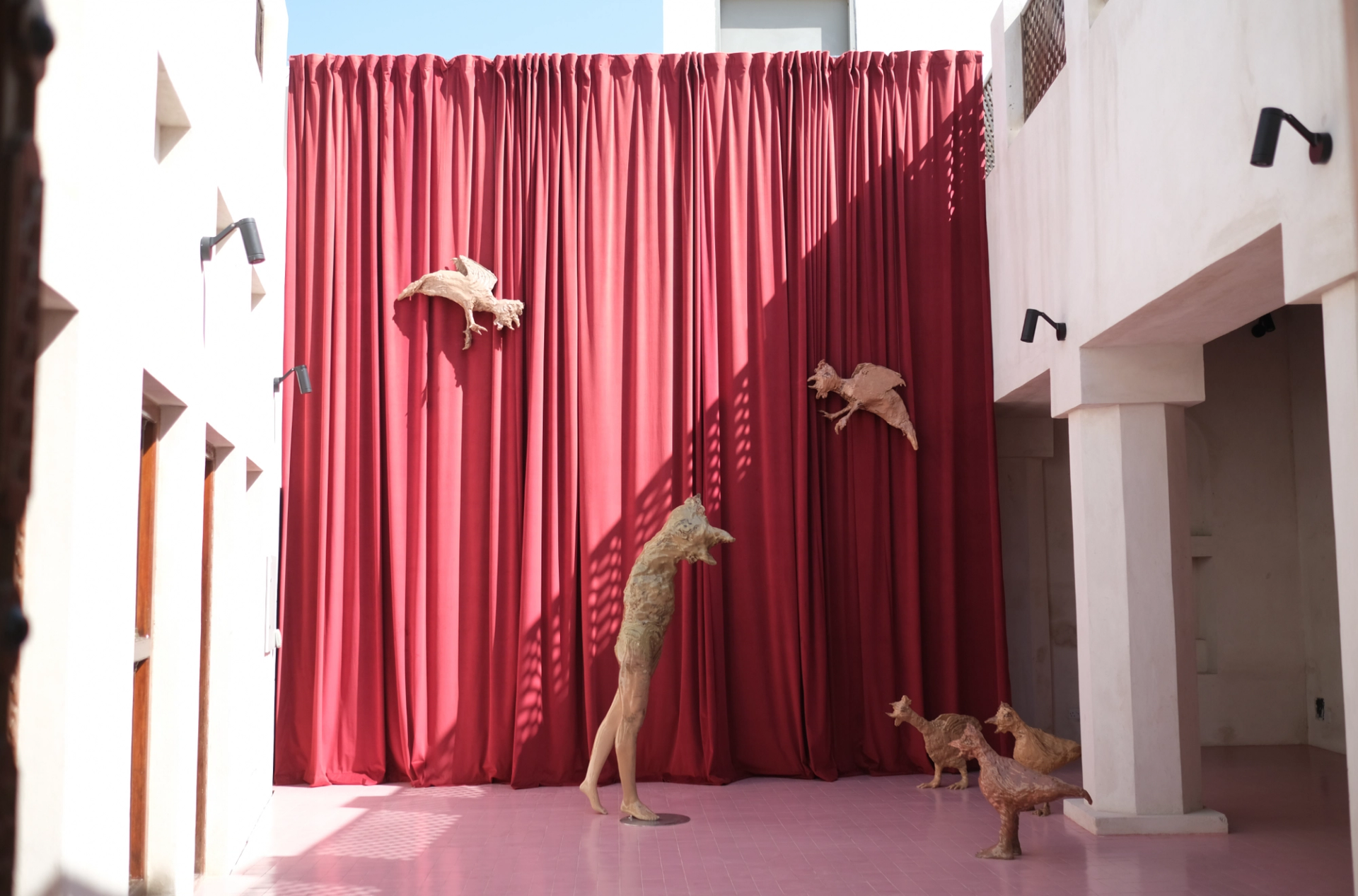
Maitha Abdalla’s installation Photo: Sueraya Shaheen
Overall, the curating feels a bit too homogeneous in places, with works grouped according to medium or subject—such as room after room of photographic documents of migration and environmental disasters in countries ranging from Armenia to Iran. At times, the art so evenly matches a space that it loses nuance as with (My) East of Eden (2012-13) by Pipo Nguyen-duy, a staged photographic series of Vietnamese schoolchildren bearing guns in lush landscapes at the Kalba Kindergarten venue. There, child-sized chairs are arranged for viewing Gabriela Golder’s films, Cartas (2018), featuring children’s recitation of letters by Argentinian political prisoners.
Gone is the more experimental flavour that set past biennials apart, particularly the last edition in 2019, which saw three curators propose works that were more fraught and less resolved. Perhaps this is a momentous occasion to reflect on how an institution comes full circle. In its 30th year, the Sharjah Biennial seems more settled and narrative-driven.
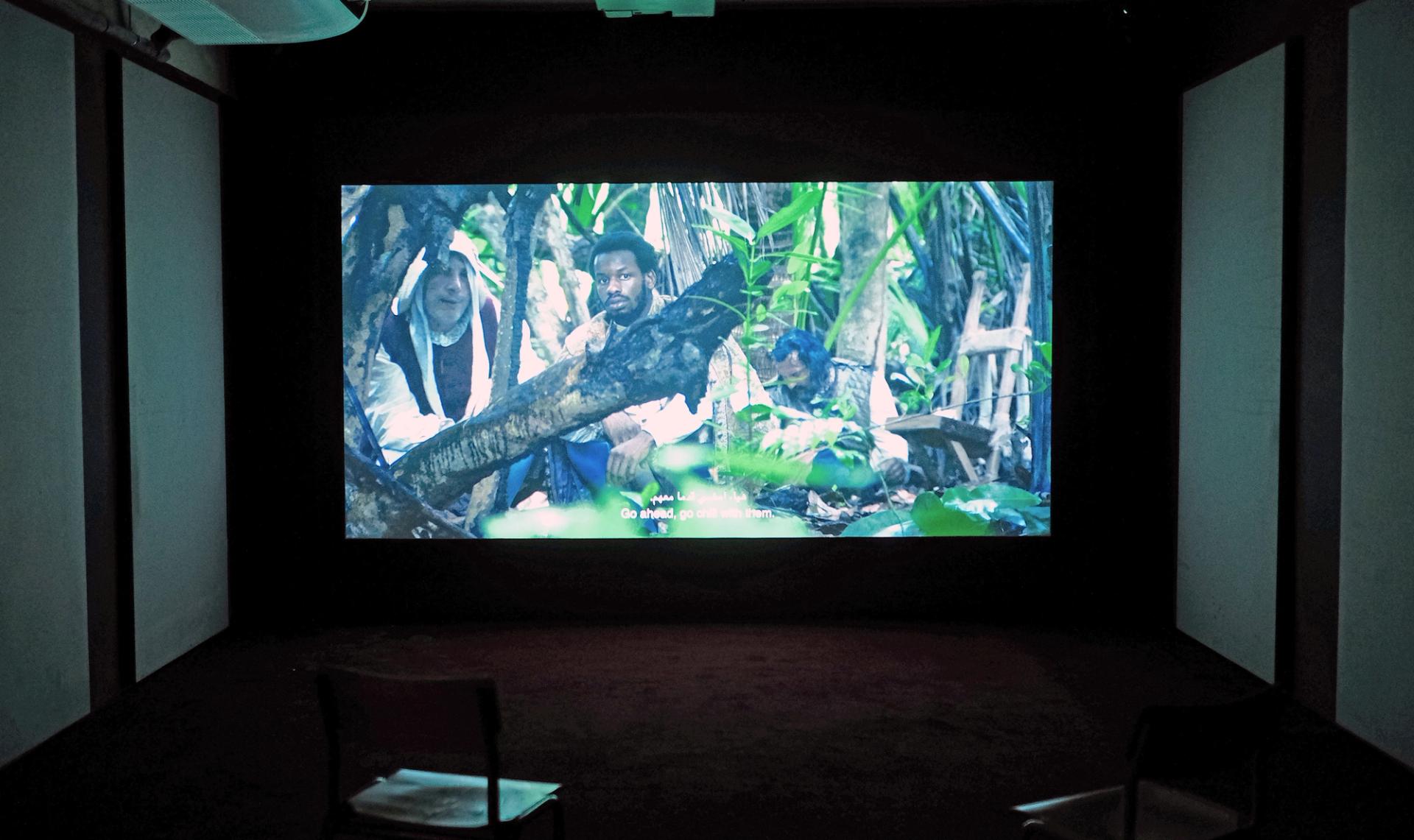
Adam Khalil's collaboration with Bayley Sweitzer and Oba, Nosferasta: First Bite (2021) Photo: Sueraya Shaheen
Some of the most captivating works are satirical films with a clear beginning, middle and end, such as Adam Khalil's collaboration with Bayley Sweitzer and Oba, Nosferasta: First Bite (2021), a vampire film with psychedelic visuals. This allegory for US hegemony through the eyes of a precarious Rastafarian immigrant allegedly bit by Christopher Columbus is unexpectedly linked to Farah Al Qasimi's film, Um Al Dhabab (Mother of Fog, 2023) in magical realism. Creatively rendered in TikTok graphics and ornate floral interiors often matching the actresses' clothing, Al Qasimi explores 17th-century myths of the Gulf through the ghost of a pirate whose remains will be displaced by a new luxury development that includes a casino—the sign of liberalism through capital.
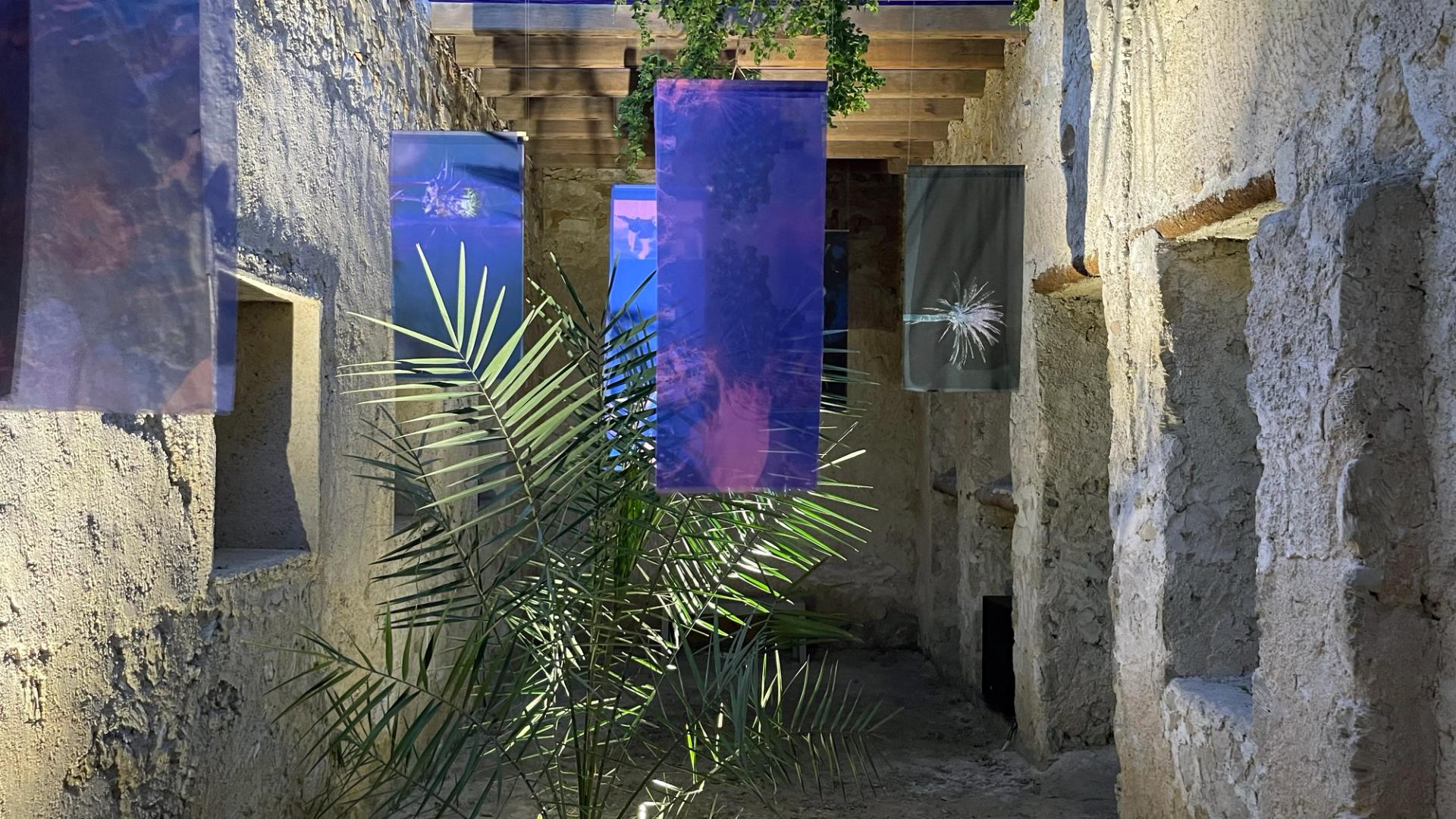
Basel Abbas and Ruanne Abou-Rahme's Until we became fire and fire us (2023) Photo: Sueraya Shaheen
The longstanding relationships the Sharjah Art Foundation has with artists was demonstrated in generous site-specific commissions. For example, Basel Abbas and Ruanne Abou-Rahme's Until we became fire and fire us (2023)—a lyrical and fragmented multi-screen projection on the Palestinian condition—is dispersed across space in the ruins of the old house Bait Haider Abadi, a formation that adheres to their expressions of uprooting. Mirna Bamieh’s takeover of a large swathe of the abandoned Old Jubail Vegetable Market, entitled Sour Things (2023), is a luscious presentation of dainty ceramics, where silver-nailed fingers hold recipes and writings on a long table candlelit setting that is flanked by stalls of fermented fruits and mouldy lemons.
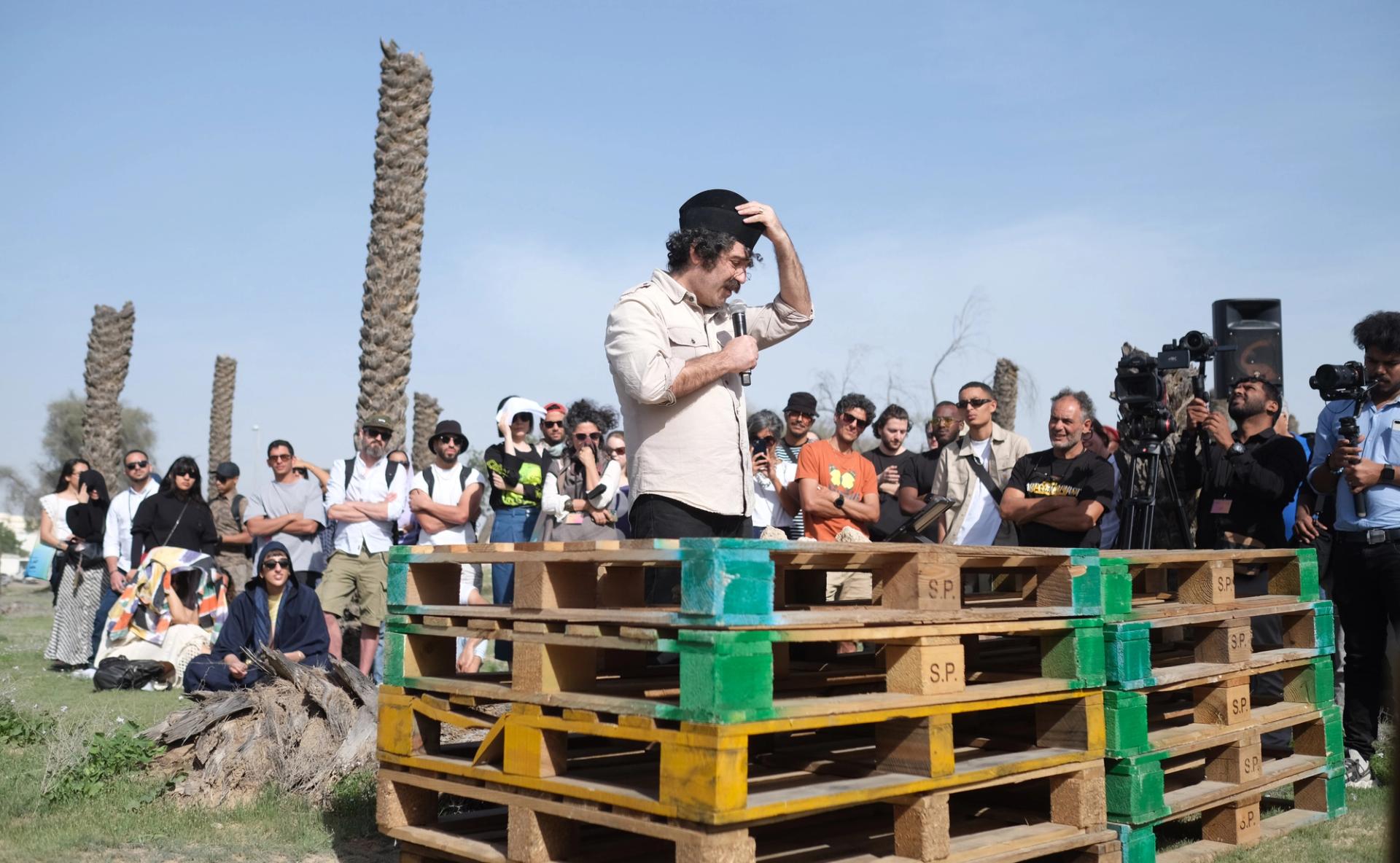
Michael Rakowitz's performance Borrowed Landscape (30.3193 ° N, 48.2543 ° E) Photo: Sueraya Shaheen
In Borrowed Landscape (30.3193 ° N, 48.2543 ° E), Michael Rakowitz reflects on the Chinese concept of Shakkei in traditional garden design, a formal composition of pre-existing natural elements in a space. His performance, situated in the abandoned farm of Al Dhaid, extrapolates from the hyphenated identities of Iraqi-Jewish ancestry to the connections that link one site to another—scorched stumps of dead palm trees echoing the dried-up date palms in war-ravaged Al Seeba in southern Iraq.
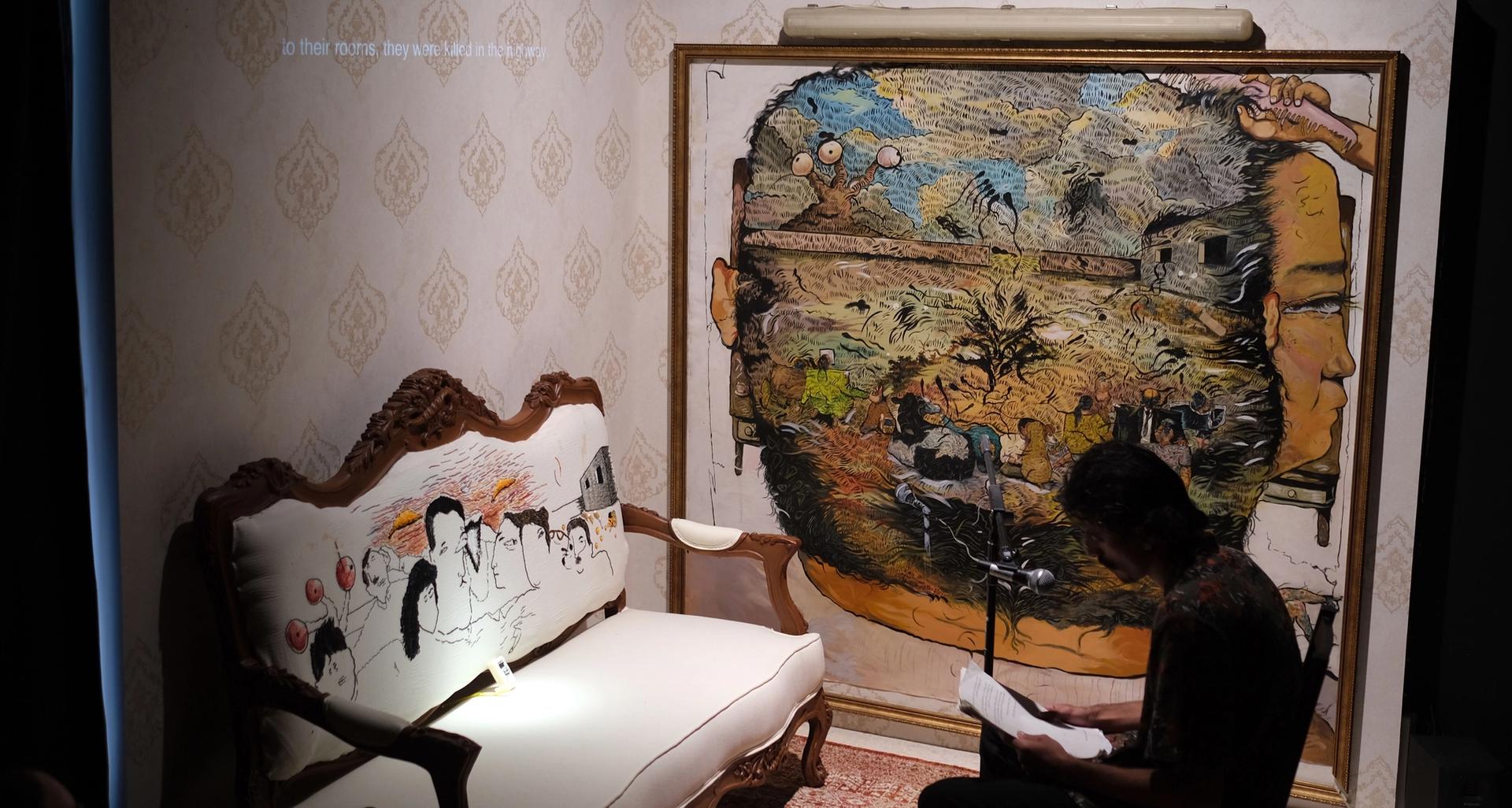
Ali Eyal’s Don't let the beautiful colors fool you, who would draw Goofy inside the rooms of grownups? (2021) Photo: Sueraya Shaheen
Also taking us back to rural Iraq was Ali Eyal’s literary performance in Arabic, Don't let the beautiful colors fool you, who would draw Goofy inside the rooms of grownups? (2021), in which the artist employs fiction as a tool to share stories of detainment, violence and becoming an artist in a room-sized installation of found objects, paintings and a couch. In The Search for Power, Tania El Khoury transports the audience to Beirut, where a power cut at her wedding led us on a participatory journey through archives that revealed electricity shortages in Lebanon dating from the 1950s (pre-civil war) and a complex web of foreign aid and corruption.
With all this transmission of language and place, it was in the spaces of encounter devoid of formulated thought—El Khoury’s invitation to viewers to dance with her in the dark, or Waheed’s sound installation voicing seven musical forms (minus their lyrics) that have been silenced by regimes of power across the world—where a lineage of ideas and creative agency was felt.
One of the keywords Enwezor shared with artists was "circularity" and while the curatorial narrative unfolds slowly in loops, it is very much sedimented and less raw in its approach. As an institution, the Sharjah Biennial has aged gracefully—and perhaps this has softened it a little.
• Sharjah Biennial 15: Thinking Historically in the Present, various venues, Sharjah, UAE, until 11 June


